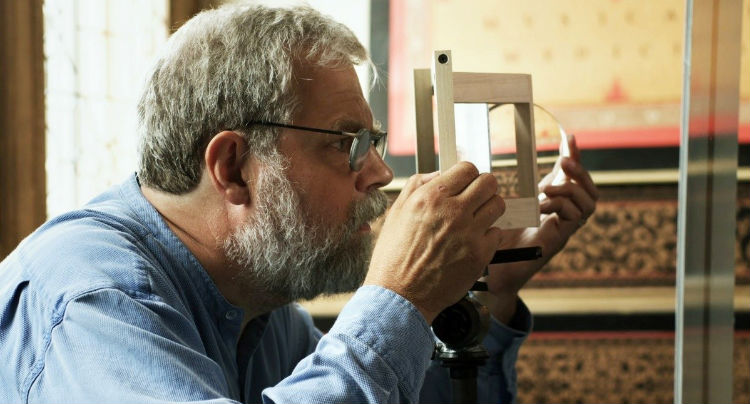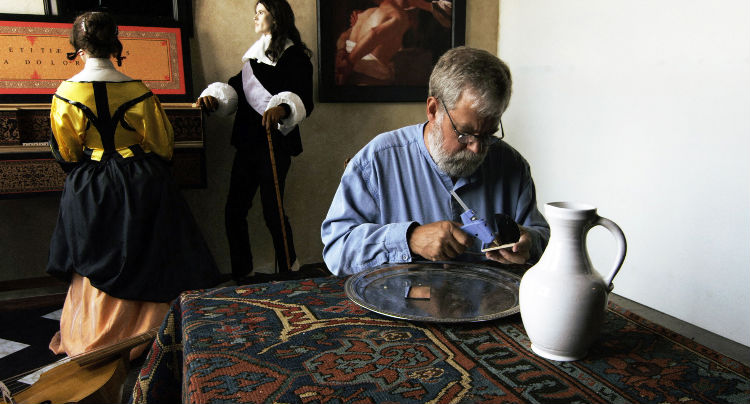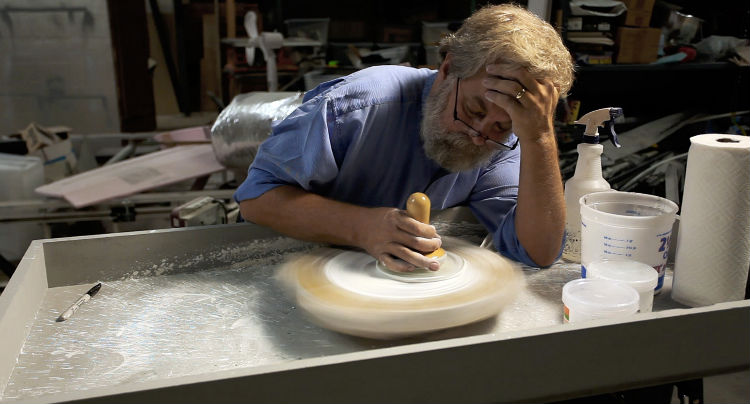
Awakens a giddy, childlike sense of discovery and curiosity few films manage to capture.

Awakens a giddy, childlike sense of discovery and curiosity few films manage to capture.
Tim Jenison’s an inventor with deep pockets (he made a killing in the video software business) and boundless ingenuity. On his spare time, he likes building things like hovercrafts and planes made out of Home Depot materials, just to challenge himself. During a casual chat with his buddies, magic funny men Penn and Teller, he came up with a challenge that would push his skills to their limits. Jenison proposed the radical idea that the impossibly photo-realistic paintings of 17th century Dutch artist Johannes Vermeer were produced via a form of pre-photography. Basically, he believes Vermeer was more of a geek (like him) than an ingenious artist. The mission: Jenison, a man with no artistic background, will attempt to replicate one of Vermeer’s paintings, “The Music Lesson”, by building a 17th century contraption of his own. The magic duo insisted the process be filmed, and…poof! We have Tim’s Vermeer.
With Teller directing and Penn producing and narrating, the film shares many traits with their Vegas act, illuminating the wonder of technical inventiveness while keeping us at arms length, emotionally. Watching Jenison attempt to crack Vermeer’s code is spellbinding, and his obsessive work ethic is something to behold, but we don’t really ever feel in touch with how the process is affecting Jenison on a deeper, human level. Is there enough substance to simply watching Jenison’s process to make this a good film? You bet there is.

Jenison isn’t a particularly verbose or charismatic documentary subject (not even close, actually), but it’s pretty moving to see how much of himself he gives to the project. Penn and Teller were right: his countless hours of research, building, engineering, and most importantly, painting, are more than worthy of being made into a film. His commitment is astounding, and it’s just so damn cool to learn that Vermeer figured out a way to hack the system and wasn’t found out for centuries!
How did he do it? Well, for years people like artist David Hockney and author Phillip Steadman (both of whom Jenison consulted during his experiment) have theorized that Vermeer had used some form of optics to create his paintings, which look so true to life they appear luminescent. Through endless hours of tinkering and trial and error, Jenison built a contraption comprised of lenses and mirrors that projected images onto canvas that he could essentially trace. (You’ve got to see it in motion to fully comprehend how it works, though it’s deceptively, ingeniously simple.) He believes that this method is exactly, or very close to, what Vermeer used to create his paintings and garner his acclaim.
Now came the time for Jenison to prove the validity of his theory by painting his version of “The Music Lesson”. He reconstructed the room in the painting to the finest detail, had people wearing accurate costume reproductions pose in the right positions, made his own paints, and began brushing away. The monumental undertaking is filmed with playful adoration, showcasing Jenison’s immaculate attention to detail as he builds the room’s furniture by hand, hunches over for hours on end to paint millions of tiny brushstrokes, and notices minutiae like the edge of a piano appearing warped due to the curvature of his contraption’s lens. The end result of the experiment is jaw-dropping.

Teller’s pretty straightforward and non-whimsical in his storytelling, which is apt, because Jenison’s experiment doesn’t need much embellishment to be interesting. One of the most controversial implications of the project is that it questions the subjectivity of Vermeer’s work. Was he, in fact, an artist, or was he just painting by numbers? Surely if a photographer is considered an artist (arranging a scene and setting a composition is undeniably subjective), Vermeer’s work is certifiably artful, just not perhaps in the way we always thought. Teller doesn’t spend much time at all delving into this polarizing subject, which is a bit of a shame, but it doesn’t hurt the film significantly or diminish Jenison’s discovery.
Tim’s Vermeer attempts to redefine the role of technology in art, boldly declaring that some works of art are products of of craftiness as opposed to genius. Despite Jenison’s soft-spoken nature and Teller’s unadorned style, the film is wildly entertaining and thought-provoking, and it awakens a giddy, childlike sense of discovery and curiosity few films manage to capture. Tim’s Vermeer is at its best when it captures the crushing tedium involved in Jenison’s (and Vermeer’s) work, as it emphasizes that we should be no less in awe of Vermeer’s accomplishments.